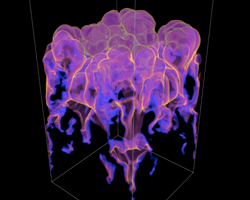
Using FLASH for Astrophysics Simulations at an Unprecedented Scale
- Code: FLASH
- Science Domain: Astrophysics
- PI: Bronson Messer, Oak Ridge National Laboratory
Description
By using the extremely scalable FLASH code, a team led by Bronson Messer plans to extend core-collapse supernova simulations to time and distance scales that can be compared with observations from, for example, space-based observatories like NuSTAR or XMM-Newton. By enhancing FLASH to make full use of next-generation computing power, the team plans an order-of-magnitude increase in the number of nuclear species tracked and evolved, increasing the physical fidelity of simulations significantly. Increasing the number of evolved nuclear species from 13 to 150 will allow accurate predictions of the amount of radioactive Titanium-44—an excellent indicator for incomplete nuclear burning—produced in core-collapse supernovae. The stretch goal of another order of magnitude, up to 2000 species, will allow in situ simulation of r-process nucelosynthesis (rapid neutron capture). The r-process is thought to produce roughly half of all the neutron-rich nuclei heavier than iron in the universe. These improvements will also be useful in simulations of thermonuclear supernovae, novae, and x-ray bursts, among other phenomena.
The Science
Researchers have long tried to understand the birth of the universe and how heavy elements were created and dispersed during those first, violent cosmic moments. Core-collapse supernovae, or stars who collapse in on themselves before rapidly exploding outward at the end of their lives, offer researchers some of the best insights into how heavy elements spread throughout the universe.
But due to the complexity of supernovae explosions, researchers can only accurately simulate 13 of well over 1000s of different elements travelling outward from a supernova explosion. The team plans to bridge the gap between explosion simulations, which cover the initial 1–2 seconds during which the star’s central engine provides the power for the supernova explosion, and the much later times when the consequences of this explosion become observable.
Due to the complex physics of a supernova explosion, how quickly it explodes, and the wide variety of elements travelling away from a supernova, current supercomputers can only accurately track a limited amount of particles.
The Team
Bronson Messer of Oak Ridge National Laboratory leads a team of world-class cosmologists that include experts from the University of Chicago, Stony Brook University, and Michigan State University.
The team’s flagship code, FLASH, is a publicly available, component-based, massively parallel, adaptive mesh refinement code that has been used on a variety of parallel platforms, from desktops to the world’s largest machines at Oak Ridge and Argonne national laboratories. FLASH was initially developed at the ASC/Alliances Center for Astrophysical Thermonuclear Flashes in the Department of Astronomy & Astrophysics at the University of Chicago (the Flash Center). The current code release has been used on more than 100 platforms.
The Goal
With access to Summit, researchers will be able to increase the number of simulated elements in a core collapse supernova from 13 to 150—with a stretch goal of improving the code to track up to 2,000—which will greatly enhance the detail and accuracy of simulations and help uncover the origins of heavy elements in nature, ultimately providing context for experimental and observational work on topics in nuclear astrophysics.
In addition to improving the fidelity of the nuclear kinetics available in FLASH, the team will also improve the overall performance of the code’s hydrodynamic module and gravity solvers, with an eye towards improving the overall multi-physics performance of the code. These improvements will also be useful in simulations of thermonuclear supernovae, novae, and x-ray bursts, among other stellar phenomena.


